Entering the Chinese market as an overseas real estate brand presents a unique set of challenges. The competitive landscape is dense, with established local players and international competitors already vying for market share. Additionally, cultural differences, regulatory hurdles, and the digital-first nature of the Chinese consumer base further complicate the marketing effort. Despite these challenges, the potential rewards are substantial, with China’s vast population and growing middle class driving demand for high-quality real estate.
One of the most critical decisions for an overseas real estate brand entering China is selecting the right online marketing channels. With the right mix of platforms, a brand can effectively reach its target audience, build brand awareness, and drive sales.

Understanding the User Journey of Chinese Real Estate Consumers
The user journey for Chinese real estate consumers can be broken down into five stages: Awareness, Research, Consideration, Decision, and Post-Purchase.
At the Awareness stage, consumers become aware of their need for a new home and start exploring their options. This is often triggered by life events such as marriage, having a child, investment, or relocating for work.
During the Research stage, consumers actively seek out information about available properties. They may use search engines, social media platforms, and real estate websites to gather information. Tailored content at this stage can help guide users towards properties that match their needs and preferences.
In the Consideration stage, consumers narrow down their options and start comparing different properties. They may visit showrooms, attend open houses, and consult with real estate agents. Content that highlights the unique selling points of a property, such as location, design, and amenities, can help sway consumers towards making a decision.
The Decision stage is when consumers commit to purchasing a property. This may involve negotiating terms, securing financing, and completing legal paperwork. Brands can support consumers at this stage by providing clear and concise information about the purchase process and offering financial and legal advice.
Finally, in the Post-Purchase stage, consumers reflect on their purchase and share their experiences with others. Brands can leverage this stage by encouraging satisfied customers to leave positive reviews and testimonials, which can help build trust and credibility among potential buyers.

Analysis of Suitable Media Channels for Real Estate in China
Baidu
Baidu, China’s leading search engine, akin to Google in the west, plays a pivotal role in the digital ecosystem. For real estate brands, Baidu offers PPC advertising opportunities that allow for targeted campaigns based on user searches. By bidding on relevant keywords, brands can ensure their listings appear prominently in search results, driving traffic to their websites.
SEO strategies tailored for Baidu are equally important. Baidu’s algorithm differs from Google’s, and understanding these nuances is crucial for optimizing content for search visibility. This includes optimizing website architecture, meta tags, and content to align with Baidu’s ranking factors.
Electronic public relations (ePR) also plays a significant role in building brand visibility on Baidu. By publishing high-quality content on we media, news platform, reputable websites, forums, and blogs, brands can increase their online presence and improve their search engine rankings. ePR efforts should focus on creating engaging, informative content that resonates with potential buyers and positions the brand as an authority in the real estate market.
Xiaohongshu (Little Red Book)
Xiaohongshu, often referred to as Little Red Book, akin to Instagram, is a social commerce platform with a strong focus on lifestyle content. Its user base is predominantly young, female, and affluent, making it an ideal platform for marketing high-end real estate.
On Xiaohongshu, brands can engage influencers to create authentic content that showcases their properties. User-generated content, such as reviews and recommendations, also holds significant sway over potential buyers. By leveraging these strategies, real estate brands can build community and trust among their target audience.
Lifestyle marketing is particularly effective on Xiaohongshu. Brands can create content that highlights the lifestyle associated with their properties, such as the nearby amenities, schools, and parks. This approach resonates with users who are not just looking for a home but for a lifestyle that matches their aspirations.
WeChat is a multifunctional platform that integrates social media, messaging, payments, and more. For real estate brands, WeChat offers an opportunity to build an official account where they can publish content, engage with followers, and provide customer service.
However, WeChat advertising for real estate faces challenges and limitations. Due to the platform’s strict advertising policies, real estate brands may find it difficult to run traditional ad campaigns. Instead, they should focus on content marketing and community-building efforts to engage their audience.
Content marketing on WeChat can include articles, videos, and infographics that provide valuable insights into the real estate market, property trends, and homebuying tips. Community-building tactics, such as interactive polls, Q&A sessions, and live events, can foster a sense of belonging among followers and keep them engaged with the brand.
Douyin (TikTok)
Douyin, the Chinese version of TikTok, is immensely popular among younger demographics. Its short-form video content and engaging algorithms make it an ideal platform for real estate brands to showcase their properties in a creative and dynamic way.
On Douyin, brands can create engaging video content that highlights the unique features of their properties. This can include virtual tours, drone footage, and behind-the-scenes looks at construction progress. Additionally, live streaming offers an opportunity to interact with potential buyers in real-time, answering their questions and addressing their concerns.

Leveraging Each Platform for Real Estate Effective Marketing
Baidu Strategies
On Baidu, real estate brands should focus on a combination of PPC, SEO, and EPR strategies. PPC campaigns should target high-intent keywords related to real estate searches. SEO efforts should prioritize optimizing website content, meta tags, and images to align with Baidu’s ranking factors. ePR strategies should involve publishing informative and engaging content on reputable websites and forums, with a focus on building brand authority and trust.
Xiaohongshu Strategies
On Xiaohongshu, real estate brands should engage influencers to create authentic content that showcases their properties. This can include lifestyle photoshoots, virtual tours, and user-generated content such as reviews and recommendations. Brands should also participate in relevant community discussions and create engaging campaigns that build community and trust among their target audience. Effective campaigns can include giveaways, contests, and collaborative events that encourage users to share their experiences and interact with the brand.
WeChat Strategies
On WeChat, real estate brands should focus on content marketing and community-building efforts to engage their audience. Content marketing can include articles, videos, and infographics that provide valuable insights into the real estate market and homebuying tips. Brands should also create interactive polls, Q&A sessions, and live events to foster a sense of belonging among followers and keep them engaged with the brand. Additionally, brands can use WeChat’s messaging features to provide personalized customer service and address any concerns or questions that followers may have.
Douyin Strategies
On Douyin, real estate brands should create engaging video content that showcases the unique features of their properties. This can include virtual tours, drone footage, and behind-the-scenes looks at construction progress. Brands should also experiment with different types of video content, such as challenges, tutorials, and user-generated content, to keep their audience engaged and entertained. Live streaming offers an opportunity to interact with potential buyers in real-time, answering their questions and addressing their concerns. Brands should take advantage of this feature to build trust and credibility with their audience.
Important Considerations
When marketing real estate in China, there are several important considerations to keep in mind. First, cultural sensitivity and understanding local customs are crucial. Real estate is deeply tied to cultural values and traditions, and brands must respect and adapt to these differences to be successful.
Regulatory compliance in real estate advertising is also essential. Brands must familiarize themselves with China’s advertising laws and regulations, particularly those related to real estate, to ensure their marketing efforts are legal and ethical.
Data privacy considerations and user trust are also important. Brands must handle user data responsibly and transparently, earning the trust of their audience through honest communication and ethical practices.
Finally, continuous performance optimization and adaptation strategies are necessary to stay competitive in the rapidly changing Chinese market. Brands should regularly analyze their marketing efforts, identify areas for improvement, and adapt their strategies accordingly.
Case Study: Emaar Properties’ Marketing Strategies in China
Emaar Properties, a leading real estate developer, has expanded its presence into the Chinese market. To effectively reach and engage with potential customers in China, Emaar Properties has implemented a comprehensive digital marketing strategy that leverages various platforms and tactics.
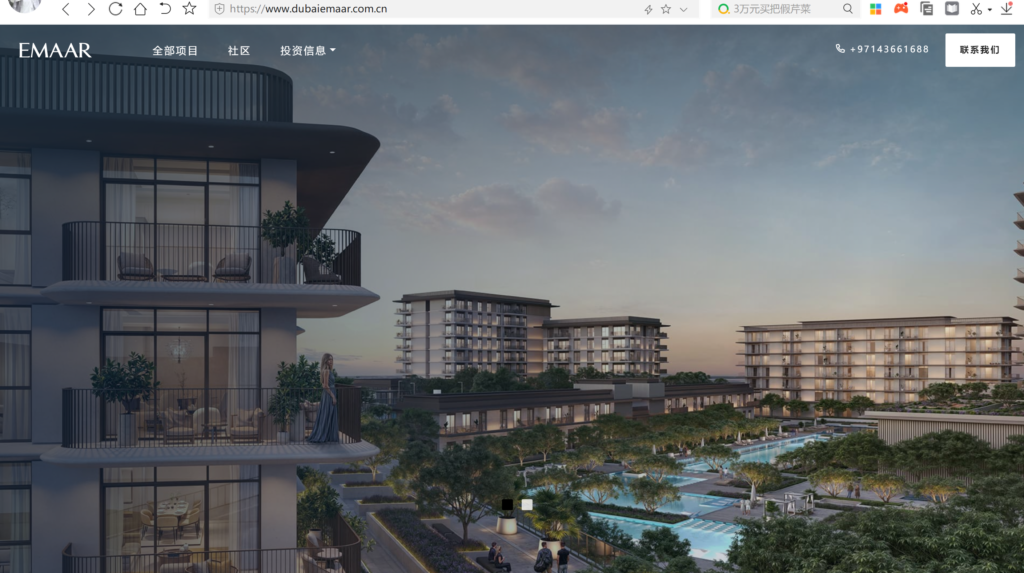
Baidu Strategy:
PPC Advertising: Emaar Properties has utilized Baidu’s PPC advertising platform to target specific keywords related to real estate, property development, and luxury homes. This allows Emaar to appear prominently in search results when potential customers are searching for relevant keywords, such as “luxury apartments in Dubai” or “new homes in Dubai”, driving traffic to its official website and increasing brand awareness.
ePR Efforts: In addition to PPC advertising, Emaar Properties has invested in ePR efforts to strengthen its online presence. This includes developing and distributing press releases, participating in online forums and discussions, and engaging with bloggers and media outlets to share news and updates about Emaar’s projects. These efforts help to establish Emaar as a trusted and authoritative voice in the real estate industry.
Baidu Baike: As part of its ePR strategy, Emaar Properties has created and maintained a comprehensive entry on Baidu Baike. This entry provides detailed information about Emaar Properties, its history, projects, and achievements. It serves as a valuable resource for potential customers who want to learn more about the company and its developments. By having a well-maintained and informative Baidu Baike entry, Emaar Properties is able to establish its credibility and expertise in the Chinese market.
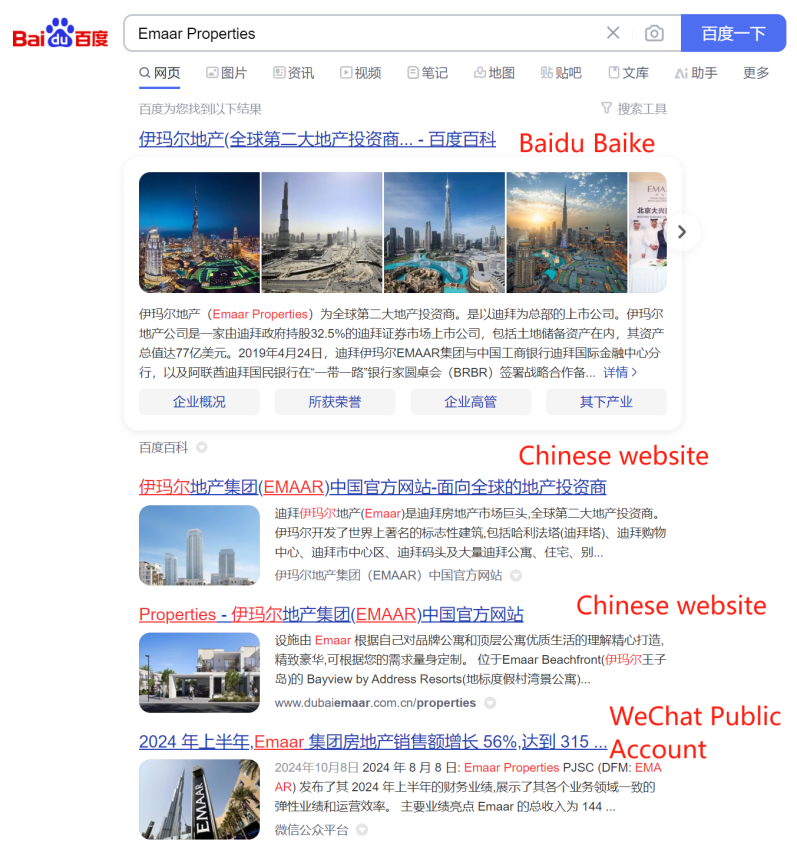
Xiaohongshu (Little Red Book) Strategy:
Account Operations: Emaar Properties has set up an official account on Xiaohongshu, where it shares updates about its projects, design concepts, and lifestyle content related to its properties. This helps to create a community of interested users and foster engagement with potential customers.
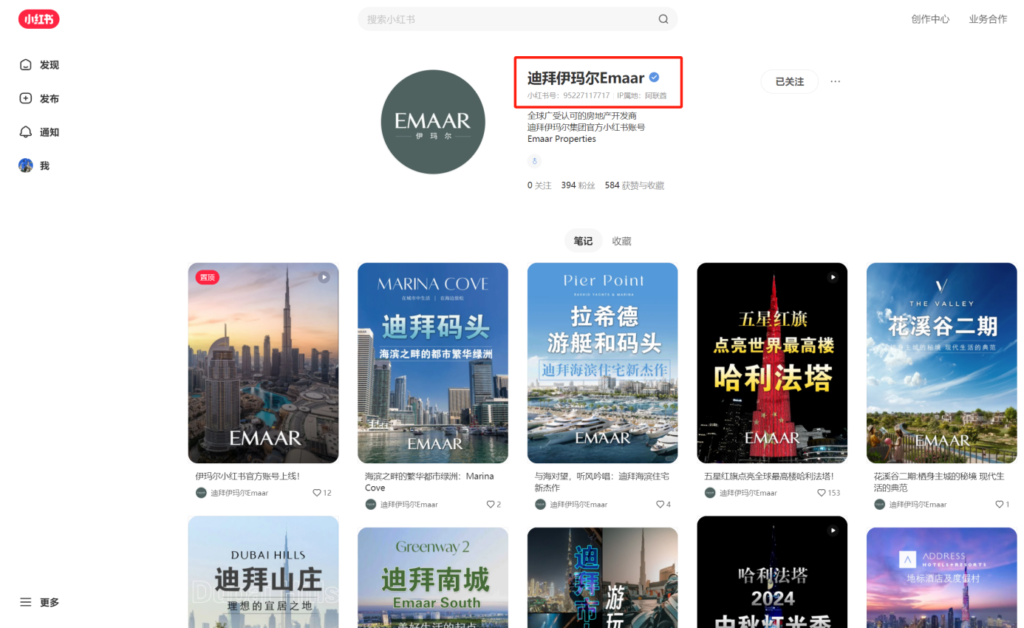
Influencer Marketing: Emaar Properties has partnered with influencers on Xiaohongshu to reach a wider audience. These influencers create content showcasing Emaar’s properties, sharing their personal experiences, and providing insights into the benefits of living in an Emaar development. This helps to build trust and credibility with potential customers.
WeChat Strategy:
Official Account Operations: Emaar Properties has an official WeChat account where it publishes articles, news updates, and promotional content related to its properties. This platform allows Emaar to directly engage with its audience, answer questions, and provide personalized support.
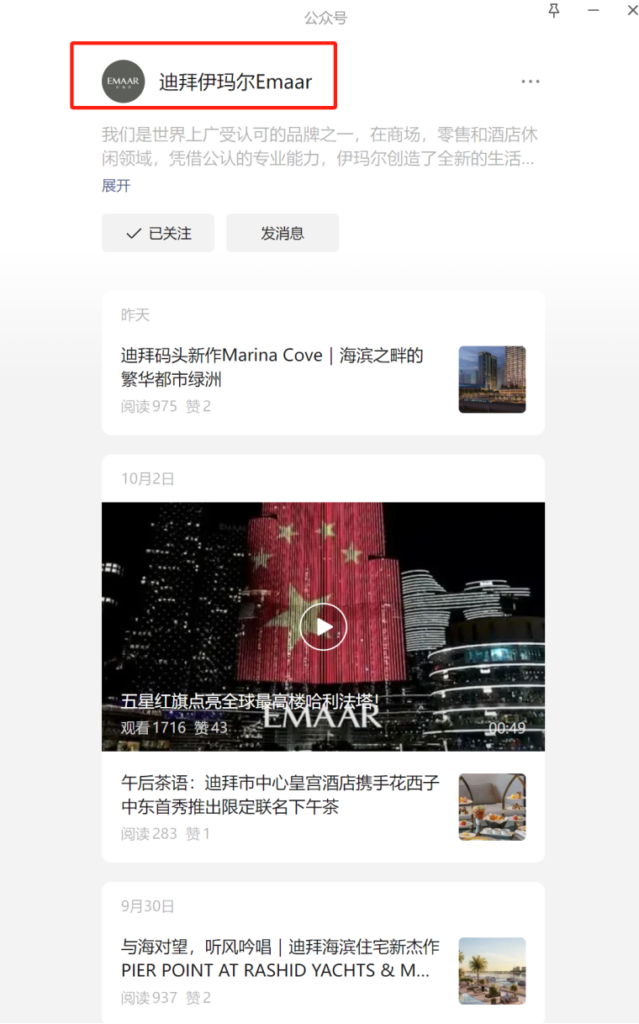
Douyin (TikTok’s Chinese Version) Strategy:
Similar to WeChat, Douyin (TikTok’s Chinese version) has been used by Emaar Properties for its public account operations.
Public Account Operations: Emaar Properties has set up a public account on Douyin, where it shares short videos showcasing its properties, design concepts, and lifestyle content. This visual format helps to capture the attention of potential customers and create a memorable impression of Emaar’s developments.
Emaar Properties has implemented a multifaceted digital marketing strategy in China, this approach helps to increase brand awareness, drive traffic to its official website, and build a loyal customer base.
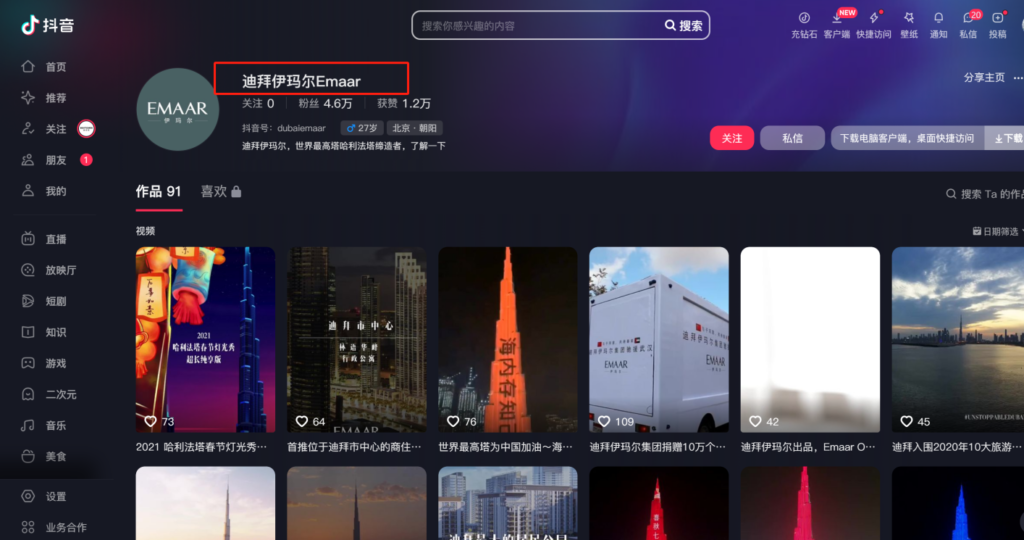
Conclusion
Entering the Chinese real estate market requires a carefully crafted online marketing strategy that leverages the unique characteristics of each platform. By understanding the user journey and employing targeted tactics on Baidu, Xiaohongshu, WeChat, and Douyin, overseas real estate brands can effectively capture the attention of Chinese consumers. As the digital landscape continues to evolve, ongoing adaptation and engagement will be vital for long-term success. Please follow Deep Digital China, we will continue to bring you the latest media policies and industry trends.
